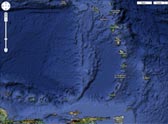Guadeloupe

Ancient figures engraved on rocks puzzle scientists
Images from the spirit world? – Hundreds of figures engraved on rocks in Southern Basse Terre, the easterly of Guadeloupe’s two main islands, pose an unfathomable mystery for scientists. Ethno-archaeologist David Laporal can only speculate: "They probably represent visions of Indian shamans".
By Bernhard Grdseloff
By Bernhard Grdseloff
Laporal is the scientific officer for "Parc des Roches Gravées", a 5-acres large public park near Vieux Fort on the southern tip of Basse Terre. The site is studded with man-high boulders, on which human-like figures have been carved. "So far we have discovered 1,200 petroglyphs in and around the park," says the scientist. "That accounts for 90% of all known Indian rock carvings in the whole Caribbean".
The reason for this high concentration remains unclear. "Maybe this was a holy place or the site of a very large settlement," guesses the 33 year-old archaeologist. "We do know from old records that the carvings were already here when the first Europeans came to Guadeloupe". But conventional scientific techniques cannot establish who created them, or when.
Laporal explains the dilemma: "Determining the age of the rocks is no problem, but that does not tell us anything about the origins of the relief's". In addition, "archaeological finds discovered in the surroundings do not take us any further, because they come from many different settlement periods, and we have not yet been able to identify a tool that was used to make the carvings".
The meaning of the images is cryptic as well. The ceramic archaeological finds from the area represent only animals, while the petroglyphs portray people. Producing them involved a great deal of work: "First the lines were chipped out from the rock point by point, and then carefully smoothed," says the scientist, who has experimented with the technique himself. "It is possible that we will be able to deduce something about their age by examining the development of the patina and fungi growth in the chinks."
The reason for this high concentration remains unclear. "Maybe this was a holy place or the site of a very large settlement," guesses the 33 year-old archaeologist. "We do know from old records that the carvings were already here when the first Europeans came to Guadeloupe". But conventional scientific techniques cannot establish who created them, or when.
Laporal explains the dilemma: "Determining the age of the rocks is no problem, but that does not tell us anything about the origins of the relief's". In addition, "archaeological finds discovered in the surroundings do not take us any further, because they come from many different settlement periods, and we have not yet been able to identify a tool that was used to make the carvings".
The meaning of the images is cryptic as well. The ceramic archaeological finds from the area represent only animals, while the petroglyphs portray people. Producing them involved a great deal of work: "First the lines were chipped out from the rock point by point, and then carefully smoothed," says the scientist, who has experimented with the technique himself. "It is possible that we will be able to deduce something about their age by examining the development of the patina and fungi growth in the chinks."













